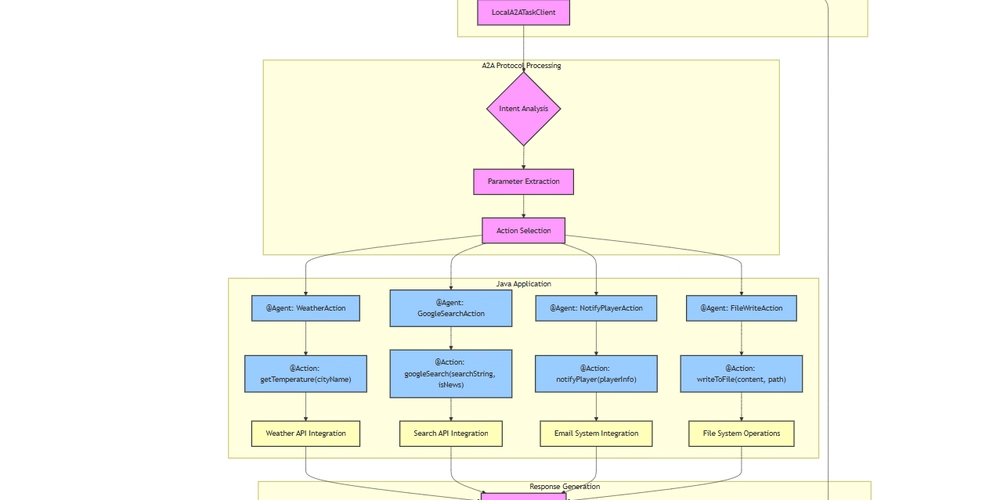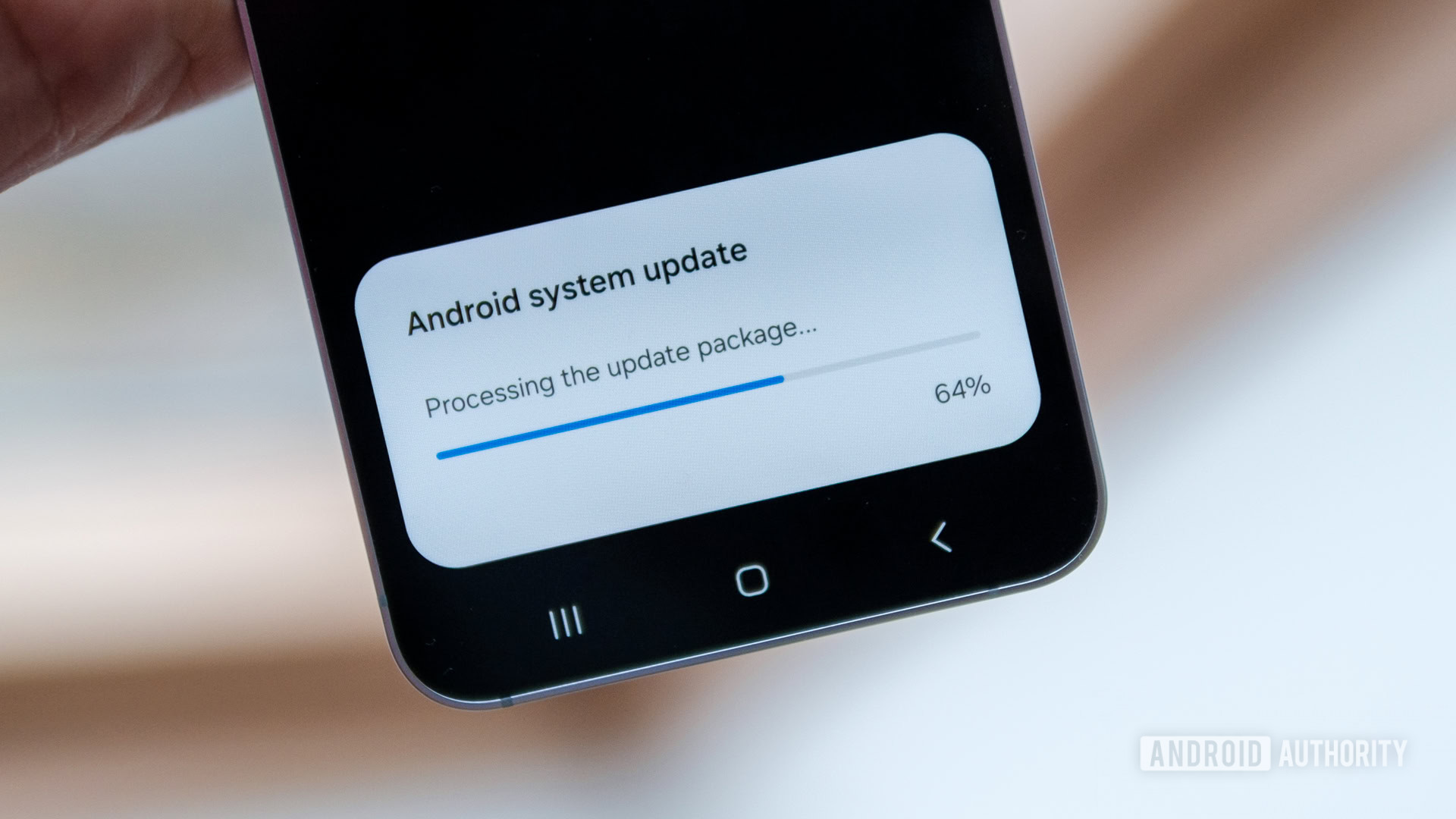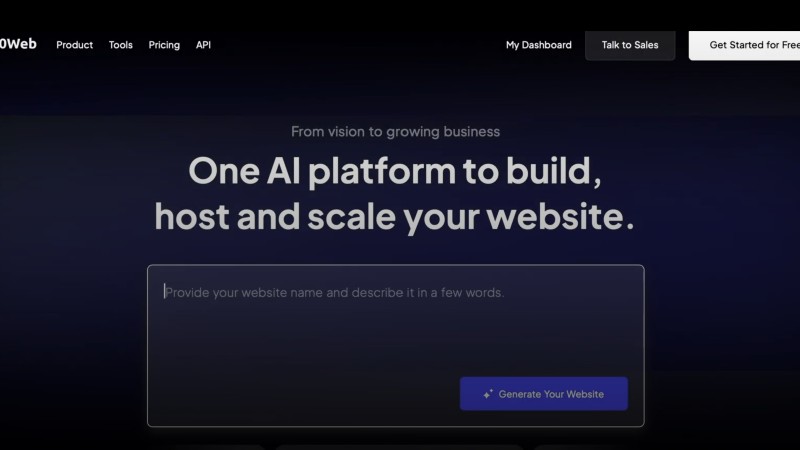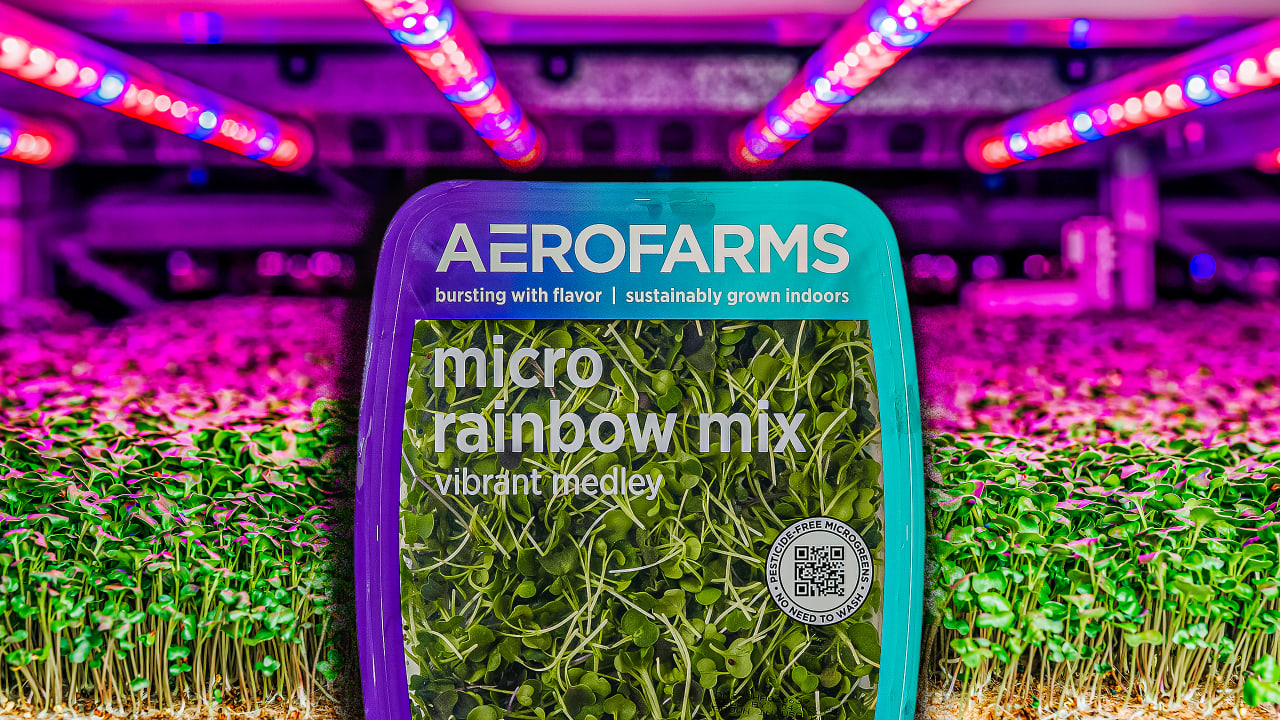Google A2A Protocol : Integrating AI into existing Java Applications
Transform your existing Java applications into AI-powered solutions without the need for a separate server infrastructure. Code for this article is here Table of Contents Introduction Prerequisites Agentic Actions Weather Service Google Search Notification System File Operations Implementation Guide Examples Best Practices Introduction This guide demonstrates how to leverage the Google A2A (Agent-to-Agent) protocol to infuse AI capabilities into your existing Java applications. The A2A protocol enables seamless integration of AI functionalities without requiring a separate server infrastructure, making it an ideal solution for enhancing your business applications with AI features. Prerequisites Before you begin, ensure you have: Java 8 or higher Maven or Gradle for dependency management Basic understanding of Spring Framework A2A library dependencies in your project Agentic Actions The power of this solution lies in its ability to create combine A2A protocol with "agentic actions" - self-contained units of business logic that can be invoked through natural language processing. Let's explore some key actions that demonstrate this capability. Weather Service The WeatherAction class demonstrates how to integrate weather data services into your application: @Log @Agent(groupName = "Weather related actions") public class WeatherAction { @Action(description = "get weather for city") public double getTemperature(String cityName) { double temperature = 0; String urlStr = "https://geocoding-api.open-meteo.com/v1/search?name="+cityName+"&count=1&language=en&format=json"; String weatherURlStr = "https://api.open-meteo.com/v1/forecast?latitude="; This action integrates with the Open-Meteo geocoding API to fetch real-time weather information for any given city. The @Agent and @Action annotations make this method accessible through natural language queries via Google A2A protocol. Google Search Integration @Agent(groupName = "GoogleSearch", groupDescription = "Google Search") public class GoogleSearchAction { @Action(description = "search the web for information") public String googleSearch(String searchString, boolean isNews) { //Just return random string if you do not have serper key //to get serper key look here https://serper.dev/ if(PredictionLoader.getInstance().getSerperKey() == null) { return "jamun , jalebi"; } This action demonstrates integration with web search capabilities. While this example uses a simplified approach, you can enhance it by integrating with the Serper API for production use. Notification System The notification system demonstrates how to send automated communications based on natural language triggers. For example, sending congratulatory emails to players based on their achievements. File Operations The FileWriteAction class handles file system operations, showcasing how traditional I/O operations can be triggered through natural language commands. Making Your Application AI-Ready The A2A protocol can be applied to any business-centric application. For example, consider a banking application: public AccountDetails getAccountDetails(AccountInformation info) { } By simply adding the @Agent and @Action annotations, you can transform regular business logic into AI-accessible endpoints. The A2A protocol handles the natural language processing and routing automatically. Implementation Examples Let's explore some practical examples of how natural language prompts trigger different actions through the A2A protocol: 1. Weather Service Integration // Initialize the A2A client LocalA2ATaskClient client = context.getBean(LocalA2ATaskClient.class); // Natural language query for weather information String weatherQuery = "Hey, I am in Toronto. Do you think I need a jacket today?"; Task weatherTask = client.sendTask(weatherQuery); // The A2A protocol automatically: // 1. Identifies this as a weather-related query // 2. Extracts the city name (Toronto) // 3. Calls WeatherAction.getTemperature() // 4. Formats a natural language response log.info(client.getTask(weatherTask.getId(), 2).toString()); 2. Automated Notifications // Natural language trigger for sending congratulations String notificationPrompt = "Sachin Tendulkar is a cricket player who joined on 24/03/2022. " + "He has played 300 matches with a highest score of 400. " + "Please send him a congratulatory email."; Task notificationTask = client.sendTask(notificationPrompt); // The system automatically: // 1. Extracts player information // 2. Generates appropriate congratulatory message // 3. Sends the email through NotifyPlayerAction log.info(client.getTask(notificationTask.getId(), 2).toString()); 3. Restaurant Booking Integration

Transform your existing Java applications into AI-powered solutions without the need for a separate server infrastructure.
Code for this article is here
Table of Contents
- Introduction
- Prerequisites
-
Agentic Actions
- Weather Service
- Google Search
- Notification System
- File Operations
- Implementation Guide
- Examples
- Best Practices
Introduction
This guide demonstrates how to leverage the Google A2A (Agent-to-Agent) protocol to infuse AI capabilities into your existing Java applications. The A2A protocol enables seamless integration of AI functionalities without requiring a separate server infrastructure, making it an ideal solution for enhancing your business applications with AI features.
Prerequisites
Before you begin, ensure you have:
- Java 8 or higher
- Maven or Gradle for dependency management
- Basic understanding of Spring Framework
- A2A library dependencies in your project
Agentic Actions
The power of this solution lies in its ability to create combine A2A protocol with "agentic actions" - self-contained units of business logic that can be invoked through natural language processing. Let's explore some key actions that demonstrate this capability.
Weather Service
The WeatherAction class demonstrates how to integrate weather data services into your application:
@Log
@Agent(groupName = "Weather related actions")
public class WeatherAction {
@Action(description = "get weather for city")
public double getTemperature(String cityName) {
double temperature = 0;
String urlStr = "https://geocoding-api.open-meteo.com/v1/search?name="+cityName+"&count=1&language=en&format=json";
String weatherURlStr = "https://api.open-meteo.com/v1/forecast?latitude=";
This action integrates with the Open-Meteo geocoding API to fetch real-time weather information for any given city. The @Agent and @Action annotations make this method accessible through natural language queries via Google A2A protocol.
Google Search Integration
@Agent(groupName = "GoogleSearch", groupDescription = "Google Search")
public class GoogleSearchAction {
@Action(description = "search the web for information")
public String googleSearch(String searchString, boolean isNews) {
//Just return random string if you do not have serper key
//to get serper key look here https://serper.dev/
if(PredictionLoader.getInstance().getSerperKey() == null) {
return "jamun , jalebi";
}
This action demonstrates integration with web search capabilities. While this example uses a simplified approach, you can enhance it by integrating with the Serper API for production use.
Notification System
The notification system demonstrates how to send automated communications based on natural language triggers. For example, sending congratulatory emails to players based on their achievements.
File Operations
The FileWriteAction class handles file system operations, showcasing how traditional I/O operations can be triggered through natural language commands.
Making Your Application AI-Ready
The A2A protocol can be applied to any business-centric application. For example, consider a banking application:
public AccountDetails getAccountDetails(AccountInformation info) {
}
By simply adding the @Agent and @Action annotations, you can transform regular business logic into AI-accessible endpoints. The A2A protocol handles the natural language processing and routing automatically.
Implementation Examples
Let's explore some practical examples of how natural language prompts trigger different actions through the A2A protocol:
1. Weather Service Integration
// Initialize the A2A client
LocalA2ATaskClient client = context.getBean(LocalA2ATaskClient.class);
// Natural language query for weather information
String weatherQuery = "Hey, I am in Toronto. Do you think I need a jacket today?";
Task weatherTask = client.sendTask(weatherQuery);
// The A2A protocol automatically:
// 1. Identifies this as a weather-related query
// 2. Extracts the city name (Toronto)
// 3. Calls WeatherAction.getTemperature()
// 4. Formats a natural language response
log.info(client.getTask(weatherTask.getId(), 2).toString());
2. Automated Notifications
// Natural language trigger for sending congratulations
String notificationPrompt =
"Sachin Tendulkar is a cricket player who joined on 24/03/2022. " +
"He has played 300 matches with a highest score of 400. " +
"Please send him a congratulatory email.";
Task notificationTask = client.sendTask(notificationPrompt);
// The system automatically:
// 1. Extracts player information
// 2. Generates appropriate congratulatory message
// 3. Sends the email through NotifyPlayerAction
log.info(client.getTask(notificationTask.getId(), 2).toString());
3. Restaurant Booking Integration
// Natural language restaurant booking request
String bookingPrompt = "Book a table at Maharaja restaurant in " +
"Toronto for Sachin Tendulkar and 4 people on May 12th";
Task bookingTask = client.sendTask(bookingPrompt);
// The system processes:
// 1. Restaurant details
// 2. Number of guests
// 3. Date and time
// 4. Customer information
Best Practices
-
Action Design
- Keep actions focused and single-purpose
- Use clear, descriptive names for actions
- Include comprehensive documentation in
@Actiondescriptions
-
Error Handling
- Implement proper exception handling
- Provide meaningful error messages
- Include fallback mechanisms
-
Testing
- Write unit tests for individual actions
- Include integration tests for A2A flows
- Test with various natural language inputs
Why this matter?
The Google A2A protocol provides a powerful way to add AI capabilities to existing Java applications. By following this guide, you can:
- Transform regular methods into AI-accessible endpoints
- Process natural language commands effectively
- Integrate multiple services seamlessly
- Maintain clean and maintainable code
The examples demonstrated here are just the beginning. The protocol's flexibility allows for integration with any business logic, making it a valuable tool for modernizing existing applications with AI capabilities.
Next Steps
- Explore more complex action combinations
- Implement custom action handlers
- Integrate with additional APIs and services
- Contribute to the A2A community
For more information and updates, visit the a2ajava official documentation and join the community discussions.










































































































































































![[The AI Show Episode 146]: Rise of “AI-First” Companies, AI Job Disruption, GPT-4o Update Gets Rolled Back, How Big Consulting Firms Use AI, and Meta AI App](https://www.marketingaiinstitute.com/hubfs/ep%20146%20cover.png)










































































































































































.png?width=1920&height=1920&fit=bounds&quality=70&format=jpg&auto=webp#)































































































_Aleksey_Funtap_Alamy.jpg?width=1280&auto=webp&quality=80&disable=upscale#)
_Sergey_Tarasov_Alamy.jpg?width=1280&auto=webp&quality=80&disable=upscale#)















































































































![Apple Foldable iPhone to Feature New Display Tech, 19% Thinner Panel [Rumor]](https://www.iclarified.com/images/news/97271/97271/97271-640.jpg)
![Apple Developing New Chips for Smart Glasses, Macs, AI Servers [Report]](https://www.iclarified.com/images/news/97269/97269/97269-640.jpg)
![Apple Shares New Mother's Day Ad: 'A Gift for Mom' [Video]](https://www.iclarified.com/images/news/97267/97267/97267-640.jpg)
![Apple Shares Official Trailer for 'Stick' Starring Owen Wilson [Video]](https://www.iclarified.com/images/news/97264/97264/97264-640.jpg)



































































































